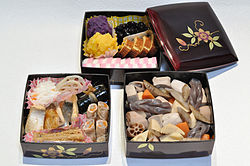Osechi
[2] Originally, osechi was rice served high in a bowl to celebrate the five annual ceremonies (gosekku) from the Nara (610-794) to Kamakura periods (1185-1333).
[3][4][5] Osechi changed greatly under the influence of honzen-ryōri, a banquet dish that was ritualized in daimyo (feudal lords) and the samurai society during the Muromachi period (1336-1573).
[3] Osechi changed greatly under the influence of honzen-ryōri, a banquet dish that was ritualized in daimyo (feudal lords) and the samurai society during the Muromachi period (1336-1573).
The three main foods known as iwaizakana (festive side dishes), such as kuromame (sugar-boiled black soybeans), tazukuri (dried Japanese anchovy), and tataki gobo (burdock boiled in vinegar and soy sauce), which are essential to today's osechi, were originally served as snacks with sake in honzen-ryōri.
Kamaboko, datamaki, and kuri kinton (chestnuts wagashi), the staples of modern osechi, were also originally honzen-ryōri, and guests would take them home to eat after the banquet.
[6] During this period, Japan experienced dramatic economic development and merchants became wealthy, and osechi became part of the culture of the chōnin (townspeople) class from the Genroku era (1688-1704) onward, and honzen-ryōri became popular among the general public.
The kuitsumi consisted of rice placed on three sides of a white wooden stand decorated with mochi, abalone, kombu, chestnuts, persimmons, Japanese spiny lobster, mikan, pine, bamboo, and plum, etc.
[6][5] With Japan's rapid economic development after World War II, osechi became more luxurious and was sold in department stores, and some of the dishes began to incorporate yōshoku (Western-style foods).

